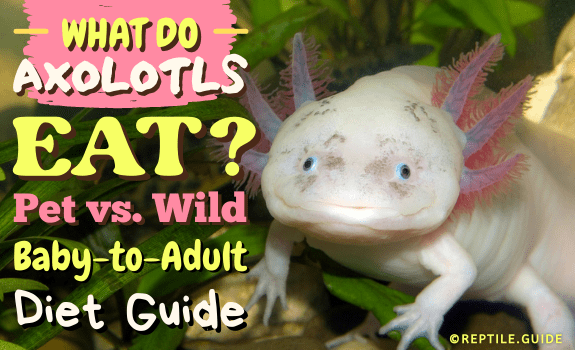What do axolotls eat? Axolotls (Ambystoma mexicanum) are carnivorous and require a protein-based diet.
As an axolotl owner, it’s important to make sure your pet axolotl gets the best diet possible.
There are several readily available, nutritious food options for owners.
This article will tell you all about them.
In This Article
What You’ll Learn
In this article, we’ll answer your questions about axolotl diets in detail, including:
- How to feed your axolotl?
- What do baby axolotls eat?
- What do axolotls eat in the wild and as pets?
- What are the healthiest foods for your pet axolotl?
What Do Axolotls Eat in the Wild?
In the wild, axolotls eat small fish, tadpoles, worms, small crustaceans, insects, larvae, and mollusks.
Axolotls were once the top predator in their natural habitat.
They’re opportunistic carnivores, eating almost anything that fits in their mouths.
They’ll also consume other salamanders and are cannibalistic, especially as juveniles.
These bottom dwellers use their lateral line system, or sensory organs, to detect movement in the water. This helps them react quickly to prey passing by.
Axolotls have rudimentary teeth. They aren’t meant for biting or chewing.
Instead, they open their mouths and inhale, sucking water and prey in.
Axolotls are difficult to study in the wild. Most of what we know about them has come from captive populations.
One thing we do know is that axolotls are nocturnal. They spend their days hidden at the bottom of lakes and hunt at night when they’re most active.
What Axolotls Eat as Pets
Axolotl food staples include:
- Pellets
- Worms
- Bloodworms
- Brine Shrimp
- Occasional treats
Your pet axolotl’s diet should be as close to what they eat in the wild as possible. This means a protein-based diet is essential.
You don’t need to give your axolotls vitamins and supplements.
They should get their nutrients from what you’re already feeding them.
So, what do axolotls eat as pets?
Let’s take a closer look at the options.
Bloodworms
Bloodworms aren’t true worms, but the larvae of non-biting midge flies. They contain haemoglobin, a protein that gives them their bright red coloration.
They’re a great staple food for babies and juveniles.
Bloodworms aren’t nutritionally balanced for adult axolotls. As they get older, only offer bloodworms on occasion.
You can purchase frozen, freeze-dried, or live bloodworms.
Frozen bloodworms are a common food choice for owners because they’re convenient and nutritional.
They can last up to six months if stored properly in your freezer.
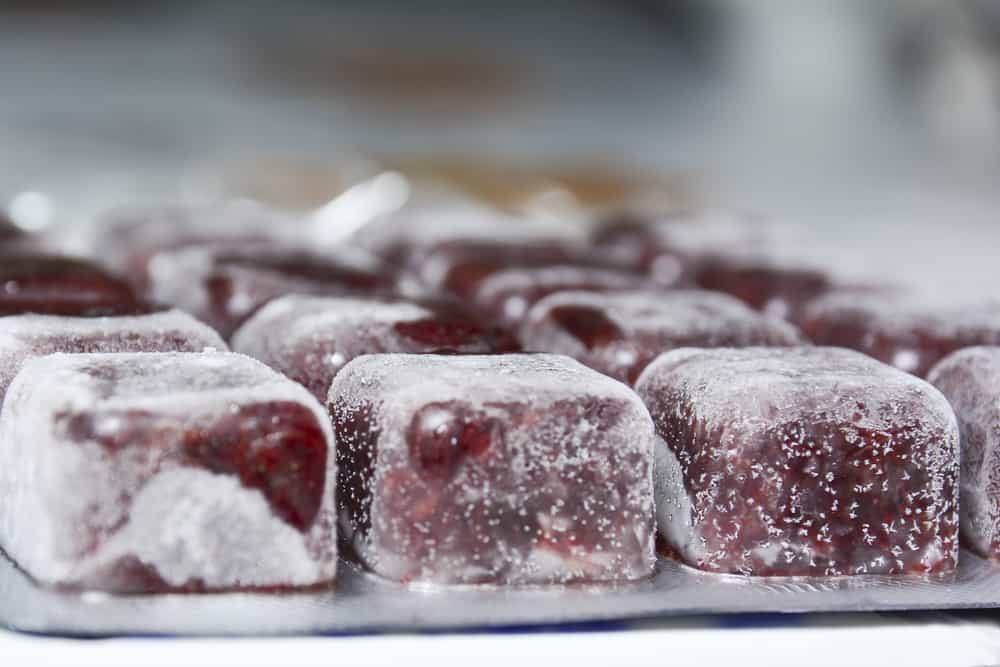
Freeze-dried bloodworms have the least nutritional value.
Soften freeze-dried bloodworms in water before offering them to your axolotl. This will make them easier to eat and help them sink to the bottom.
Live bloodworms are the most nutrient-rich of the three options.
Like all other live foods, bloodworms have a risk of carrying parasites and diseases. It’s best if they’re sourced from fish-free waters.
Feed live bloodworms within two to three days.
Worms
Earthworms, nightcrawlers, and red wigglers are staple foods full of the nutrients your axolotl needs.
You can feed worms to axolotls of all ages. You’ll need to cut them into small pieces until your axolotl is big enough to consume a whole worm.
Dangle a thrashing worm in front of your axolotl and watch them snatch it up as their instincts kick in.
Wash worms before feeding them to your axolotl to avoid polluting the water.
Avoid purchasing worms from bait shops. Look for worms sourced from chemical-free soil.
With a little effort, you can even keep a worm farm at home.
Many experts agree live worms are the best food source for your axolotl.
Brine Shrimp
Brine shrimp are another popular food choice for axolotl owners.
They’re inexpensive and packed with nutrients perfect for your axolotl’s health needs.
Live baby brine shrimp are great for juvenile axolotls. Adult axolotls won’t notice baby brine shrimp and need full-grown adults.
Purchase brine shrimp frozen, freeze-dried, or live. They can also be home-cultured.
Frozen brine shrimp come in cubes, like bloodworms. You’ll need to thaw them before feeding.
One negative of feeding brine shrimp is that they’re messy.
Live brine shrimp die quickly and will pollute the water. Your tank will need a water change within 24 hours after feeding.
Frozen brine shrimp also create a mess. Remove any uneaten food quickly.
The best way to contain the mess is to pipette the brine shrimp into a bowl or other container.
Pellets
Pellets are another convenient and common food source for axolotl owners. The right pellets can provide your axolotl with all the nutrients it needs.
Once your juvenile axolotl reaches 1.5 to 2 inches in length you can begin supplementing their live diet with pellets.
There are several pellet options formulated specifically for axolotls. You can also use commercial fish or turtle pellets.
It’s important to feed pellets with high-quality ingredients. Look for ones that are high in protein and low in fat. Aim for 40% protein or higher.
There are different sizes and types of pellets available.
The best pellets for your axolotl are:
- Soft pellets – Hard pellets can be more difficult for your axolotl to digest. You can still use them, but soak them in water beforehand to soften them.
- Sinking pellets – These are great for axolotls because they’re bottom dwellers. Sinking pellets will fall to the bottom of your tank, where your pet is likely to be spending most of its time.
- The correct size – They range from extra small for juvenile axolotls to extra large for bigger adult axolotls. Soft pellets that come in one size are usually easy to break into small portions as well.
- Shrimp or salmon pellets – These have great nutritional values and are easy to find. Shrimp and Salmon pellets are very popular among axolotl keepers.
The only downside to pellets is that you may need to train your axolotl to eat them.
They might not understand that a pellet is food if they’re used to live prey moving or thrashing in front of them.
After your axolotl successfully eats pellets a few times they should start seeking them out.
Axolotls can find pellets by smell. Look for ones with a strong odor to encourage eating.
It’s a good idea to supplement a pellet diet with live prey. Variety will keep your axolotl healthy and enriched.
Some pellets break down in water more quickly than others.
While you want the pellets to be soft, you don’t want them to disintegrate before your axolotl can eat them.
Pellets left in your aquarium too long can foul up the tank and alter the water chemistry. Remove any uneaten pellets.
If you’re looking for a reliable pet axolotl food and supplies online store, we recommend Chewy!
They sell river shrimp pellets your axolotl will love! Click here to save 30% on your first order.
We may receive a small commission if you purchase after clicking.
This does NOT change what you pay or what we recommend.
It does help fund the research we put into the site, and we’re grateful for any support!
Other Foods
Certain foods are safe for axolotls, but only on occasion.
If you want to give your adult axolotl a special treat, or need them to put on some weight, try:
- Waxworms
- Prawn meat
- Butterworms
- White worms
- Ghost shrimp
- Tubifex Worms
- Pieces of raw fish meat
- Strips of beef liver or heart
Always feed treats in addition to your axolotl’s regular diet to assure they’re still receiving the proper nutrients.
What Do Baby Axolotls Eat?
Freshly hatched axolotls survive off of the yolk sack from their egg for the first 24 to 48 hours. After that, baby axolotls need live foods.
They’re born with the instinct to snap at anything that moves.
The best live food options for baby axolotls include:
- Daphnia
- Bloodworms
- Baby Brine Shrimp
Your baby axolotl can start eating pellets when it reaches 1.5-2 inches in length.
Juvenile axolotls can eat worms cut into small pieces until they’re large enough to take whole ones.
A study on captive axolotls found that when fed a diet of only bloodworms, axolotls grew significantly faster than those fed daphnia or a combination of the two.
For more information on raising baby axolotls take a look at our care guide.
Feeding Your Pet Axolotl
Feeding schedules and methods vary. You should consider age, food type, and health condition when feeding your axolotl.
Axolotls are naturally nocturnal, meaning they do their hunting at night. As pets, they can retain these habits.
You may have to adjust your feeding times based on when your axolotl is the most active.
How Often to Feed Your Axolotl
How often you feed your axolotl will depend on its age.
- Feed baby axolotls every day.
- Feed juvenile axolotls once or twice a day.
- Feed an adult axolotl every other day, or two to three times a week.
Axolotls have slow metabolisms, meaning it will take a few days for them to fully digest their food.
Warmer temperatures will increase your axolotl’s metabolism. You will need to feed them more often.
Too hot and your axolotl won’t want to eat at all.
Keep your axolotl’s tank cool. The water temperature should be between 60-64 degrees Fahrenheit.
Adult axolotls can go up to three weeks without eating, but we DON’T recommend this.
Your axolotl will stop eating when it’s full. Some owners use the “two-minute rule”.
Let your axolotl eat as much as it can in two minutes, then remove any leftover food.
Be mindful of overfeeding your axolotl.
An overfed axolotl will poop more. This makes your tank messier and affects the water chemistry.
Axolotls can become obese. When axolotls are at a healthy weight, their abdomens should be as wide as their heads.
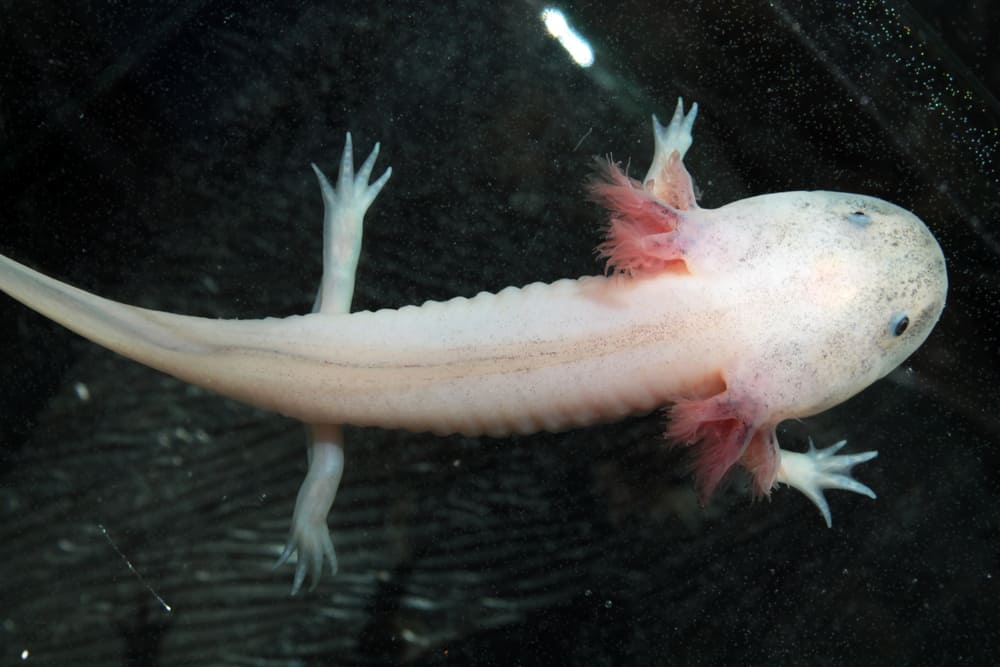
How to Feed Your Axolotl
You can feed your pet axolotl using several techniques, depending on the type of food:
- Tongs – Rounded tongs work great for feeding worms and pellets. Hold the food right in front of their faces.
Let worms thrash in front of your axolotl, or wiggle non-living foods around to entice them.
- Pipettes – It’s easiest to feed water-based foods, like live brine shrimp and daphnia, slowly through a pipette or turkey baster.
This will help keep free swimming foods contained in one area of the tank.
This method also works well for frozen-then-thawed foods, like bloodworms.
Pipettes are a popular feeding technique that help reduce messes in your aquarium.
- Drop food in – You can drop the food right in front of your axolotl’s face. It should be close enough that they can feel it drop past them, or touch their nose.
This technique is common when feeding axolotls pellets.
This may make it hard for them to find their food.
If you drop food in, it should be able to sink to the bottom of the tank, where your axolotl is more likely to find it.
Feeding in the same location of your axolotl’s tank each time will help them know it’s feeding time.
You can feed your axolotl in a dish to reduce waste and make clean-up easier.
Feeding in a container will also help reduce the risk of obstructions (see the section on health considerations).
You’ll even see your axolotl waiting in its food dish for its meal!
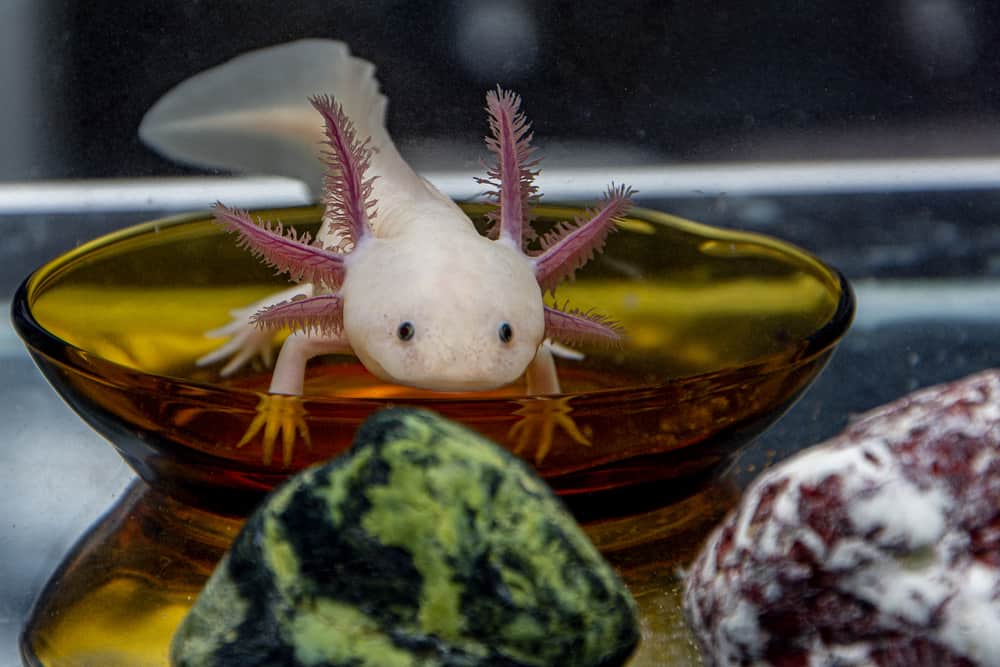
Axolotls are intelligent enough to be target trained.
They’ll quickly start to recognize your tongs, pipette, or other target objects and know it’s time for food.
Remove any leftover food from the tank once your axolotl is full.
Old food can pollute the tank, causing unwanted bacteria that can be harmful to your axolotl.
Health Considerations
There are several important things to consider when feeding axolotls:
- Chitin – Axolotls can’t process chitin, a protein in the exoskeletons of insects and crustaceans.
Because of this, avoid feeding your axolotl anything with a hard outer shell.
This includes mealworms, crickets, roaches, and shrimp shells.
- Choking – You won’t see your axolotl chewing with their rudimentary teeth.
To avoid food getting stuck in their throat, make sure they can swallow what you’re feeding them whole.
You may need to cut axolotl food into smaller pieces.
- Impaction – Impaction occurs when something gets stuck in your axolotl’s digestive system.
Impactions are usually caused by non-organic materials that your axolotl can’t digest.
As they inhale their food they’re also sucking in whatever else is around them.
Be sure that any substrate in your axolotl’s tank is too big to fit in their mouths or small enough to pass through their system.
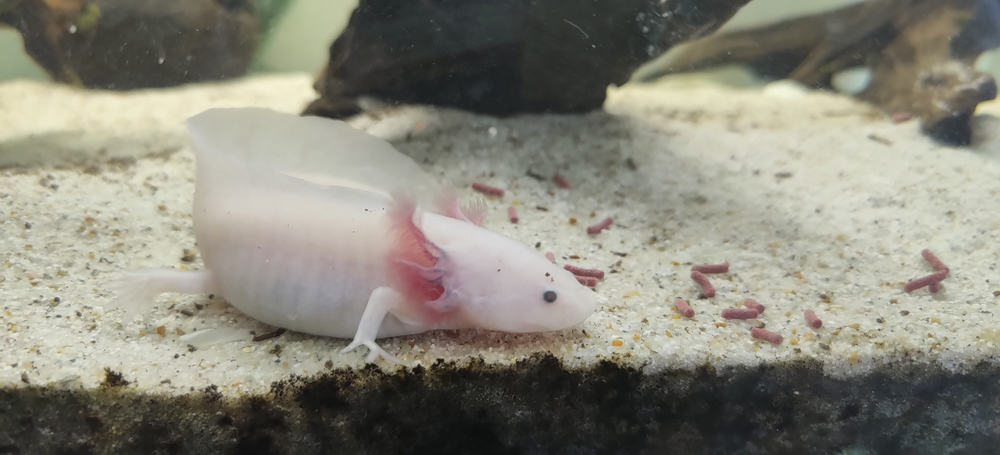
- Parasites – Live food can carry parasites and diseases that are harmful to axolotls.
Never feed anything taken from the wild. Look for live food sourced from fish-free waters.
- Air in the abdomen – Signs of air in the abdomen include floating upside-down and a distended stomach.
Juveniles are especially susceptible as they transition to higher protein diets.
Their immature digestive systems will adjust on their own. Try reducing their portion sizes to help with the transition.
Some keepers hand feed their axolotls. This method is okay, but be mindful not to touch your axolotl.
Wash your hands before feeding your axolotl to avoid passing any unwanted bacteria.
Poor appetite can be a sign that your axolotl isn’t feeling well.
If you’re concerned about your axolotl’s health, ask a professional for proper veterinary guidance.
Can Axolotls Eat Cat Food?
We DON’T recommend feeding your axolotl cat food.
Cat foods have plant-based ingredients and preservatives that are not healthy for an axolotl.
If you’re looking for a convenient food option, commercial pellets are better suited for your axolotl’s nutritional needs .
Can Axolotls Eat Bloodworms?
Yes! Axolotls love bloodworms.
They’re a great food choice for pet axolotls, especially babies and juveniles.
Bloodworms are more of a treat for adult axolotls because they lack all of the necessary nutrients needed.
You can purchase live, freeze-dried, or frozen bloodworms.
What Fish Do Axolotls Eat?
Feeding your axolotl live fish is risky. They carry parasites and diseases that can be harmful to your axolotl.
There is also the risk that fish will mistake your axolotl’s gills for food.
Whether or not feeding your axolotl live fish is worth the risk is highly debated among experts.
If you want to feed live fish,quarantine them for at least 30 days, or raise them at home.
You can feed your axolotl slow-moving freshwater feeder fish. They should be small enough for your axolotl to swallow whole.
A few options:
- Goldfish
- Guppies
- Minnows
Some owners will gut load their feeder fish beforehand to increase nutritional value.
You can also feed axolotls pieces of boneless fish meat. Cut small strips of raw salmon, carp, or trout as a rare treat.
Do Axolotls Make Good Pets?
Yes, axolotls make excellent pets.
Axolotls have become increasingly popular as pets. They’re engaging and easy to take care of as long as you have experience with freshwater systems.
The most difficult aspects of caring for an axolotl are their tank chemistry and specific water temperature needs.
Axolotls have simple diets and are inexpensive to feed.
If properly cared for, axolotls can live up to 15 years in captivity.
Adult axolotls reach an average length of 9 inches, but can reach up to 18 inches.
Like reptiles, you can purchase a variety of color morphs from axolotl breeders. All morphs require the same diet and care.
When Can Axolotls Eat Pellets?
Axolotls can eat pellets when they reach a length of 1.5-2 inches.
You may have to train your axolotl to eat pellets.
Since babies and juveniles enjoy more enticing live foods, they might not show an interest in pellets right away.
Axolotl (a.k.a. Mexican Walking Fish) Background Information
Axolotls, also called Mexican walking fish, are completely aquatic for their entire lives.
Axolotls are neotenic, so unlike other amphibians, they never leave their larval stage. Adult axolotls retain their external gills, giving them their unique look.
Although rare, axolotls can go through a full metamorphosis in the wild. Iodine injections can induce metamorphosis in lab settings.
This means they’ll lose their external gills and become terrestrial as adults, like other salamanders.
Axolotls that undergo this forced metamorphosis usually live for only a few months.
Where Do Mexican Walking Fish Live?
Axolotls once lived in Lake Xochimilco and Lake Chalco outside of Mexico City, Mexico.
Now, their only remaining natural habitat exists in Lake Xochimilco and a few areas surrounding it.
You can also find axolotls in Lake Chapultepec. Lake Chapultepec exists within a 1,695 acre park inside of Mexico City.
Habitat loss, pollution, and the introduction of invasive species have led to a drastic loss of wild axolotls.
According to the IUCN Red List, there are between 50 and 1,000 axolotls left in the wild.
Although they’re critically endangered in the wild, axolotls are easily found in captivity.
They’re frequently used in lab studies because of their ability to regenerate body parts.
Before purchasing an axolotl, make sure you’re familiar with your local laws.
If you’re searching for the perfect aquatic pet, check out the 7 best pet frogs.
Wondering what other cool amphibians eat? Find out what toads eat in captivity and the wild.
Already an axolotl owner? Let us know in the comments what your axolotl loves to eat.
